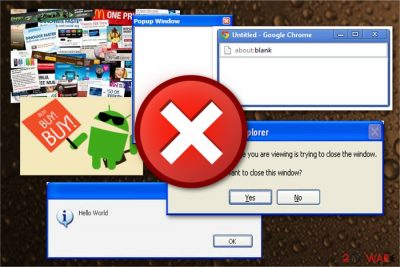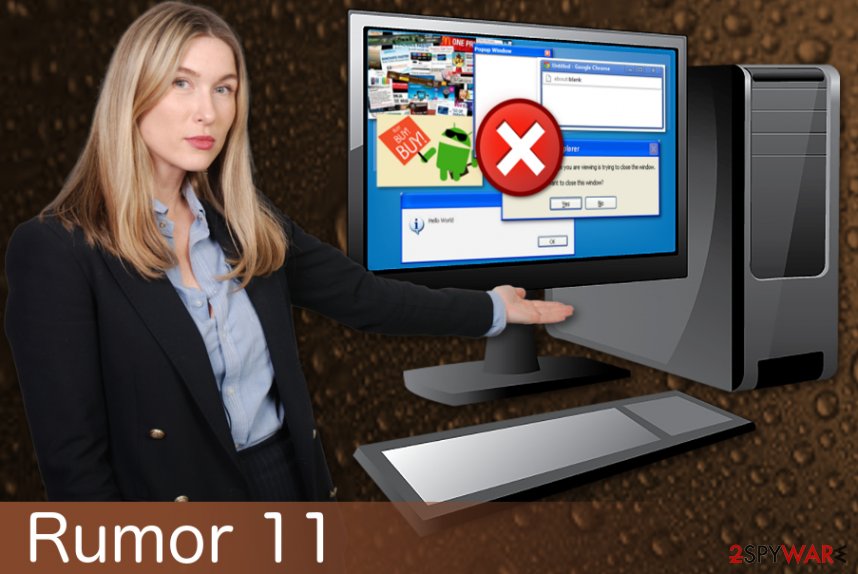Rumor 11 (Free Guide) - Virus Removal Instructions
Rumor 11 Removal Guide
What is Rumor 11?
Rumor 11 is a dubious program that installs into the system without your consent

Rumor 11 is a potentially unwanted program that is designed to display intrusive advertisements. Security experts categorize it as adware[1] because its primary goal is to redirect users to sponsored websites and gain monetary benefit for each of the clicks made by users. Victims encounter pop-ups, banners, offers, deals, in-text links and similar content directly from their Internet Explorer, Google Chrome or Mozilla Firefox browsers. Although adware is almost harmless, it can eventually lead to hazardous websites and infect users' computers with dangerous viruses.
| Name | Rumor 11 |
|---|---|
| Type | PUP; adware |
| Symptoms | Redirects to affiliate sites, pop-up ads |
| Affected browsers | IE, Firefox, Chrome |
| Distribution | Software bundles |
| Elimination | The best tool for adware removal is FortectIntego |
The prime goal of adware is to display ads and make users click on them, or even redirect them to questionable sites. Nevertheless, for each website visit and redirect to the affiliate domain, PUP authors receive money. Unfortunately, the end user receives nothing in return, apart from an ads-filled browser which makes browsing sessions miserable. If you are looking for Rumor 11 removal methods, you came to the right place – read this article, and you will find out how.
The continual redirects can also open several tabs at the time, and expose inappropriate or offensive content. Therefore, people with kids at home should be careful if the Rumor 11 virus is present on the machine. What is more, the potentially unwanted program can lead victims to dangerous websites where malicious JavaScripts[2] can download and install malware on their computers. This happens because adware authors do not check the content of their affiliates, as they only care about gaining revenue.
There is another good reason to remove Rumor 11, and it is data tracking. Once your system is infected with adware, its developers can collect a variety of non-personally identifiable information about you, which includes, but is not limited to:
- Geo-location;
- IP address;
- Internet service provider;
- Technical data;
- Search data;
- Links clicked and websites visited, etc.
This data is used in order to personalize ads and display it to the correct audience. Also, in some cases, adware may also collect personal information which can later be shared with third-parties or even crooks, which can abuse that information for personal gain.
To conclude, we would like to suggest you get rid of Rumor 11 as soon as possible. In case you don't even realize which adware program is causing these redirects and ads, simply scan your computer with FortectIntego – it will quickly detect all PUPs automatically.

Unwanted and intrusive programs come in bundles with freeware
Potentially unwanted programs come in bundles during freeware installation. If you skip through steps, you are likely to install additional components that can affect your PCs performance. Virusi.bg[3] reminds you that you should be cautious online.
These bundles are formed by adware developers and freeware authors – both sides sign a contract, which guarantees successful distribution of PUPs. Nevertheless, you can always avoid unwanted applications if you pay attention while installing new software. If you chose Advanced or Custom options during the installation, you could prevent additional components. By doing so, you expose the full list of optional programs and can de-select them by removing the pre-selected tick-marks.
Get rid of Rumor 11 and any related programs
To remove Rumor 11 properly, you should employ professional anti-malware tool and scan your system. This will help you to make sure that the system is immaculate from infections. Also, full system scan using anti-spyware application should be in your security routine.
If you do not trust your ability to perform Rumor 11 removal – do not worry and follow our guide below. These step-by-step instructions were written as clearly as possible and can guide you through manual adware elimination. Be aware that infection can come back if you clean your system incorrectly.
You may remove virus damage with a help of FortectIntego. SpyHunter 5Combo Cleaner and Malwarebytes are recommended to detect potentially unwanted programs and viruses with all their files and registry entries that are related to them.
Getting rid of Rumor 11. Follow these steps
Uninstall from Windows
Eliminate virus from your Windows OS:
Instructions for Windows 10/8 machines:
- Enter Control Panel into Windows search box and hit Enter or click on the search result.
- Under Programs, select Uninstall a program.

- From the list, find the entry of the suspicious program.
- Right-click on the application and select Uninstall.
- If User Account Control shows up, click Yes.
- Wait till uninstallation process is complete and click OK.

If you are Windows 7/XP user, proceed with the following instructions:
- Click on Windows Start > Control Panel located on the right pane (if you are Windows XP user, click on Add/Remove Programs).
- In Control Panel, select Programs > Uninstall a program.

- Pick the unwanted application by clicking on it once.
- At the top, click Uninstall/Change.
- In the confirmation prompt, pick Yes.
- Click OK once the removal process is finished.
Delete from macOS
Remove items from Applications folder:
- From the menu bar, select Go > Applications.
- In the Applications folder, look for all related entries.
- Click on the app and drag it to Trash (or right-click and pick Move to Trash)

To fully remove an unwanted app, you need to access Application Support, LaunchAgents, and LaunchDaemons folders and delete relevant files:
- Select Go > Go to Folder.
- Enter /Library/Application Support and click Go or press Enter.
- In the Application Support folder, look for any dubious entries and then delete them.
- Now enter /Library/LaunchAgents and /Library/LaunchDaemons folders the same way and terminate all the related .plist files.

Remove from Microsoft Edge
Delete unwanted extensions from MS Edge:
- Select Menu (three horizontal dots at the top-right of the browser window) and pick Extensions.
- From the list, pick the extension and click on the Gear icon.
- Click on Uninstall at the bottom.

Clear cookies and other browser data:
- Click on the Menu (three horizontal dots at the top-right of the browser window) and select Privacy & security.
- Under Clear browsing data, pick Choose what to clear.
- Select everything (apart from passwords, although you might want to include Media licenses as well, if applicable) and click on Clear.

Restore new tab and homepage settings:
- Click the menu icon and choose Settings.
- Then find On startup section.
- Click Disable if you found any suspicious domain.
Reset MS Edge if the above steps did not work:
- Press on Ctrl + Shift + Esc to open Task Manager.
- Click on More details arrow at the bottom of the window.
- Select Details tab.
- Now scroll down and locate every entry with Microsoft Edge name in it. Right-click on each of them and select End Task to stop MS Edge from running.

If this solution failed to help you, you need to use an advanced Edge reset method. Note that you need to backup your data before proceeding.
- Find the following folder on your computer: C:\\Users\\%username%\\AppData\\Local\\Packages\\Microsoft.MicrosoftEdge_8wekyb3d8bbwe.
- Press Ctrl + A on your keyboard to select all folders.
- Right-click on them and pick Delete

- Now right-click on the Start button and pick Windows PowerShell (Admin).
- When the new window opens, copy and paste the following command, and then press Enter:
Get-AppXPackage -AllUsers -Name Microsoft.MicrosoftEdge | Foreach {Add-AppxPackage -DisableDevelopmentMode -Register “$($_.InstallLocation)\\AppXManifest.xml” -Verbose

Instructions for Chromium-based Edge
Delete extensions from MS Edge (Chromium):
- Open Edge and click select Settings > Extensions.
- Delete unwanted extensions by clicking Remove.

Clear cache and site data:
- Click on Menu and go to Settings.
- Select Privacy, search and services.
- Under Clear browsing data, pick Choose what to clear.
- Under Time range, pick All time.
- Select Clear now.

Reset Chromium-based MS Edge:
- Click on Menu and select Settings.
- On the left side, pick Reset settings.
- Select Restore settings to their default values.
- Confirm with Reset.

Remove from Mozilla Firefox (FF)
Clean your browser following these steps:
Remove dangerous extensions:
- Open Mozilla Firefox browser and click on the Menu (three horizontal lines at the top-right of the window).
- Select Add-ons.
- In here, select unwanted plugin and click Remove.

Reset the homepage:
- Click three horizontal lines at the top right corner to open the menu.
- Choose Options.
- Under Home options, enter your preferred site that will open every time you newly open the Mozilla Firefox.
Clear cookies and site data:
- Click Menu and pick Settings.
- Go to Privacy & Security section.
- Scroll down to locate Cookies and Site Data.
- Click on Clear Data…
- Select Cookies and Site Data, as well as Cached Web Content and press Clear.

Reset Mozilla Firefox
If clearing the browser as explained above did not help, reset Mozilla Firefox:
- Open Mozilla Firefox browser and click the Menu.
- Go to Help and then choose Troubleshooting Information.

- Under Give Firefox a tune up section, click on Refresh Firefox…
- Once the pop-up shows up, confirm the action by pressing on Refresh Firefox.

Remove from Google Chrome
Delete malicious extensions from Google Chrome:
- Open Google Chrome, click on the Menu (three vertical dots at the top-right corner) and select More tools > Extensions.
- In the newly opened window, you will see all the installed extensions. Uninstall all the suspicious plugins that might be related to the unwanted program by clicking Remove.

Clear cache and web data from Chrome:
- Click on Menu and pick Settings.
- Under Privacy and security, select Clear browsing data.
- Select Browsing history, Cookies and other site data, as well as Cached images and files.
- Click Clear data.

Change your homepage:
- Click menu and choose Settings.
- Look for a suspicious site in the On startup section.
- Click on Open a specific or set of pages and click on three dots to find the Remove option.
Reset Google Chrome:
If the previous methods did not help you, reset Google Chrome to eliminate all the unwanted components:
- Click on Menu and select Settings.
- In the Settings, scroll down and click Advanced.
- Scroll down and locate Reset and clean up section.
- Now click Restore settings to their original defaults.
- Confirm with Reset settings.

Delete from Safari
Remove unwanted extensions from Safari:
- Click Safari > Preferences…
- In the new window, pick Extensions.
- Select the unwanted extension and select Uninstall.

Clear cookies and other website data from Safari:
- Click Safari > Clear History…
- From the drop-down menu under Clear, pick all history.
- Confirm with Clear History.

Reset Safari if the above-mentioned steps did not help you:
- Click Safari > Preferences…
- Go to Advanced tab.
- Tick the Show Develop menu in menu bar.
- From the menu bar, click Develop, and then select Empty Caches.

After uninstalling this potentially unwanted program (PUP) and fixing each of your web browsers, we recommend you to scan your PC system with a reputable anti-spyware. This will help you to get rid of Rumor 11 registry traces and will also identify related parasites or possible malware infections on your computer. For that you can use our top-rated malware remover: FortectIntego, SpyHunter 5Combo Cleaner or Malwarebytes.
How to prevent from getting adware
Choose a proper web browser and improve your safety with a VPN tool
Online spying has got momentum in recent years and people are getting more and more interested in how to protect their privacy online. One of the basic means to add a layer of security – choose the most private and secure web browser. Although web browsers can't grant full privacy protection and security, some of them are much better at sandboxing, HTTPS upgrading, active content blocking, tracking blocking, phishing protection, and similar privacy-oriented features. However, if you want true anonymity, we suggest you employ a powerful Private Internet Access VPN – it can encrypt all the traffic that comes and goes out of your computer, preventing tracking completely.
Lost your files? Use data recovery software
While some files located on any computer are replaceable or useless, others can be extremely valuable. Family photos, work documents, school projects – these are types of files that we don't want to lose. Unfortunately, there are many ways how unexpected data loss can occur: power cuts, Blue Screen of Death errors, hardware failures, crypto-malware attack, or even accidental deletion.
To ensure that all the files remain intact, you should prepare regular data backups. You can choose cloud-based or physical copies you could restore from later in case of a disaster. If your backups were lost as well or you never bothered to prepare any, Data Recovery Pro can be your only hope to retrieve your invaluable files.























